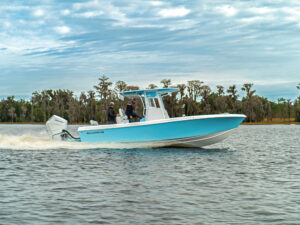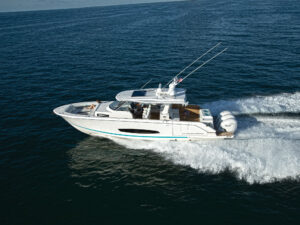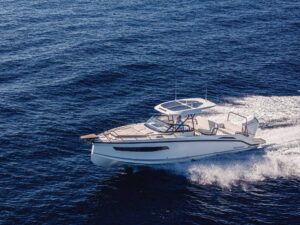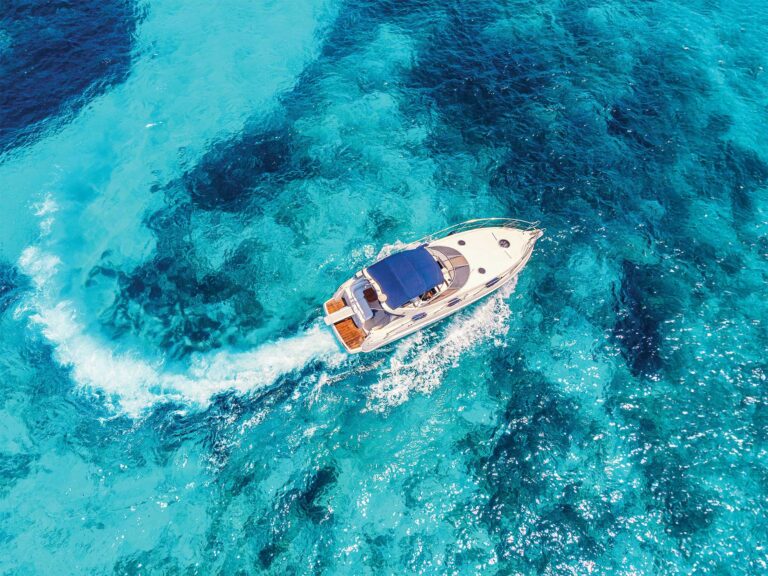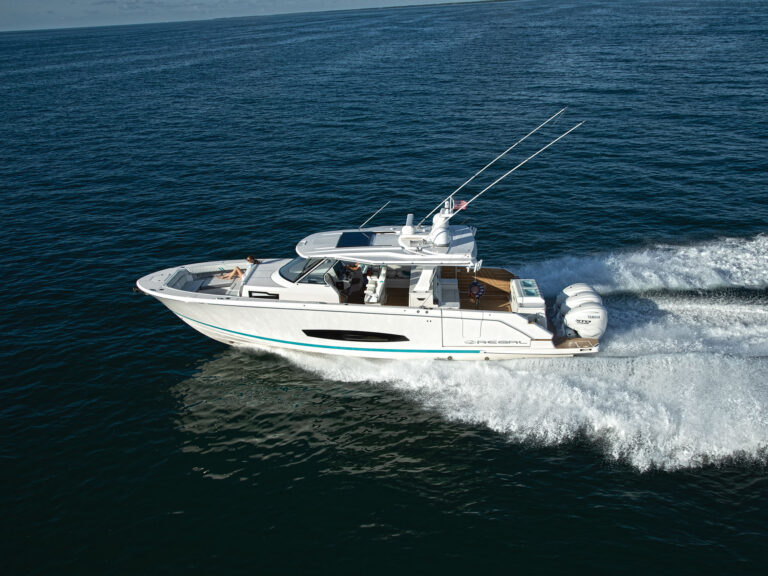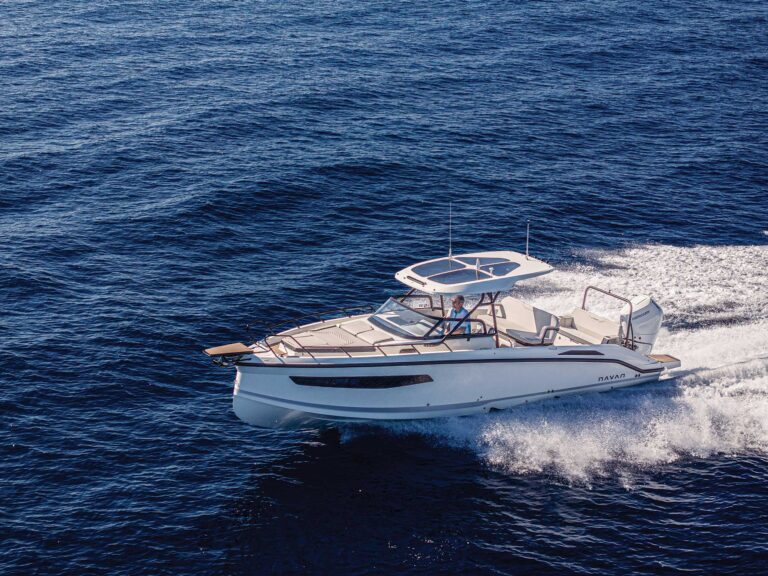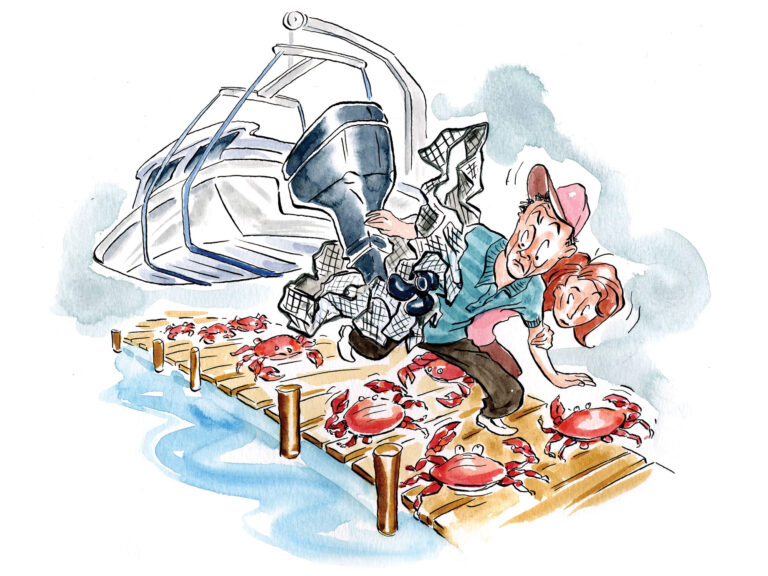During its first half-century, the outboard was something you’d put only on a rowboat. Real powerboating was for the rich. But as outboards got bigger and better, the average American family could hit the water, too. And we did, in ever-growing numbers, thanks to the outboard motor.
In the decade before World War II, Americans bought 750,000 outboards. In 1956 – in one year – we bought close to 600,000 of them. Pleasure boating had become a $1.3 billion business, with one boat for every 28 of us, and that number was growing at twice the rate of automobiles. Why the sudden change? Because the outboard itself had changed.
Underwater exhaust hushed the racket, pushbutton starting replaced grunting on a pull rope, and dependability meant engines kept running as long as you poured in the gas. Power increased so we could have bigger, more comfortable boats. And prices stayed low. In 1946 we paid $28.60 per horsepower; in 1956 it was down to $23.60. Outboards and the new interstate highway system made the trailerable boat possible, so a new backyard navy that could go anywhere was born. The outboard had finally come of age, and we eagerly went along for the ride.
****Who Was First?****
In 1896 the American Motor Co. of Long Island City, New York, may have built the first internal-combustion outboard. Historians suspect that a few air-cooled four-strokes were produced, but no one is sure.
We’re positive, however, that in 1903 Yale law student Cameron Waterman removed the engine from his powered bicycle for an end-of-season service, clamped it to the back of a chair, and fired it off. Waterman, an avid angler, imagined the chair as a boat’s transom. The idea stayed with him, and in 1905 he and a friend rigged a Curtiss motorcycle engine to a propeller via a drive chain – which they then discarded in favor of a drive shaft.
In 1906 Waterman passed out brochures at the New York Boat Show, prompting the production of 25 Waterman outboards-and the start of an era. The first model was prone to overheating, so in 1907 a water-cooled version was offered. A campaign promoting the Waterman in national magazines featured the first use of the term “outboard motor” in advertising. Sales reached 6,000 in 1909. Soon to be dubbed the Waterman Porto, it improved over the years before the company was sold in 1917 to the Arrow Motor and Machine Co., which closed in 1924.
Founding Fathers
The true stories behind the men and their machines.
Evinrude
Ole Evinrude came from Norway to Wisconsin at age five, quit school after the third grade to work on his family’s farm, and grew up to become a self-taught machinist. He was a natural, but he had no mind for finance, leaving a trail of failed businesses. Fortunately, his wife, Bess, made up for this. When Ole emerged from his shop with a prototype outboard in 1909, she gave him hell for wasting time and materials on a “silly coffee grinder.” But when he returned from a successful outing on a rented rowboat, she saw dollars in the little single-cylinder kicker.
Bess suggested Ole revise the design, and she launched a local ad campaign: “Don’t Row! Throw Away Those Oars! Use an Evinrude Motor!” They sold 25 hand-built Evinrudes in 1909. Each weighed 62 pounds, made 1.5 hp, and cost $62. In 1910 Bess launched a national ad campaign and they were overwhelmed with orders. It was the start of an empire and the popularity of outboards.
In 1913 Ole sold out with a five-year noncompete agreement. In 1921 he returned with a lightweight aluminum twin-cylinder outboard called the Elto (Evinrude Light Twin Outboard), which was an instant success. In 1929 Elto merged with Evinrude and Lockwood, which were owned by Briggs and Stratton. Ole Evinrude was now president of the Outboard Motors Corp. (OMC), which stayed in business until 2000 building boats as well as engines.
Johnson
In 1908 18-year-old Lou Johnson and his younger brothers, Clarence and Harry, attempted to build a small inboard engine to power their rowboat. They made their own patterns and castings, and the engine actually worked. The next year they built an aircraft engine and the airplane to go with it, which in 1911 made the first successful monoplane flight in America. They opened an aviation school, which was destroyed by a tornado, and then began building small engines to power bicycles.
That business didn’t last, so the brothers modified their engine and introduced it at the 1922 New York Boat Show as the Johnson Light Twin outboard. Weighing a mere 35 pounds compared to 60-pound competing motors, this aluminum engine made 2 hp. It could be tilted for beaching and swiveled 360 degrees for reverse. It was also relatively reliable and easy to start. By 1923 Johnson sold 7,000. Outboards were going to be their future.
Johnson was the first outboard builder to market speed and performance. In 1926 its 6-hp P-30 Big Twin pushed a boat to 23 mph, an astounding speed at the time. However, during the Depression the company faltered and was bought by Ralph Evinrude (Ole’s son) at Outboard Marine in 1935. By 1937 Johnson sales exceeded those of Evinrude and Elto, with the 1 millionth Johnson outboard being produced in 1952.
Kiekhaefer Mercury
In 1938 Carl Kiekhaefer bought a factory with the idea of manufacturing dairy equipment and discovered 300 Thor outboard motors in a back room. These were a low-cost design built under contract as a private label for Montgomery Ward. The motors ran so poorly, however, that Ward cancelled. Kiekhaefer planned to sell them for scrap but tinkered with the carburetor until they ran well. Ward took the modified inventory and soon requested more.
The old tooling was still in the plant, and Kiekhaefer fired up the assembly line. He updated the design and printed a brochure offering three Thor models, from a 6.2-hp triple to a 2.4-hp single. Meanwhile, Kiekhaefer began working on an all-new outboard, and the first Mercury debuted at the New York Boat Show in 1940. Two 3-hp singles and a 6-hp twin were offered, and Kiekhaefer left with 16,000 orders.
Unfortunately, before Mercury could get rolling, World War II began. When it ended, production of new outboards started, featuring sleek cast-aluminum cowls finished in deep green. The 10-hp Lightning model was exceptionally fast and began a Kiekhaefer tradition of purposely underrating the power of its motors to earn a better performance reputation. The 1949 Mercury four-cylinder Thunderbolt said “25” on the cowl but made more than 40 hp. From then on Mercury became known as the hot rod of outboards.
Next to the Lawn Mowers…
Department store brands brought boating to the heartland. Over the years outboard builders re-branded their products for private retailers, getting more of us on the water.
| BRAND | BUILT BY | SOLD AT |
| Brooklure | Gale | Spiegel Inc. |
| Firestone | Scott-Atwater, West Bend | Firestone Tire Stores |
| Elgin, Motorgo, | Sears, Waterwitch Caille, Evinrude, Johnson, Lockwood | Sears-Roebuck |
| Sea Bee | Gale | Goodyear Tire Stores |
| Sea-Flyer | Champion, Gale | B.F. Goodrich Tire Stores |
| Wizard | Chrysler, Mercury, Scott-Atwater | Western Auto Supply |
“They Called It What?”
Odd names and odder histories:
• Aquabug: A micro-horsepower kicker with interchangeable gas or electric powerheads.
• Chris-Craft: Yep, Chris-Craft built engines from 1949 to 1953 to power its smaller boats.
• Evenride: A ripoff of you-know-who that quickly died in the 1960s.
• Fageol: Not a pasta, but a small four-stroke car engine with a beefed-up Scott-Atwater lower unit.
• Fussomatic: A goofy one-off built for Mercury to show the worst features of other brands.
• Gopher: A motor produced by a professor and his students in the 1920s.
• Harley Davidson: Experimented around 1920 but sold none.
• Lionel: From the company that gave us toy trains.
• Nip-N-Tuck: Matched set of electric trolling motors, one for each side of your canoe.
• Ro-No-Mo: Like the No-Ro, Motorow, and Row-No-More. Who needs oars?
• Submerged: A 1906 electric outboard that predicted gas engines were a fad. It soon sank.
• Ted Williams: Sold through Sears in the 1960s in an attempt to capitalize on his angling exploits.
• Walnut: Died before Evinrude made outboards popular. Could have been a contender. Nuts!
Doing Its Part
By the time production of recreational outboards was formally halted in February 1942, most builders were already doing other work for the military. Germans, however, were proving the value of outboard-powered boats to ferry troops over rivers, and America soon followed. Outboards were used to move pontoon bridges, and 300,000 Allied troops were ferried over the Rhine by outboards in just 24 hours. Outboards of up to 50 hp-huge for the day-were used for reconnaissance. The Navy developed a rescue kit with an inflatable boat and an outboard that could be dropped to downed fliers. It was responsible for saving 700 airmen.
Outboard Wars
Carl Kiekhaefer considered OMC a hated enemy. With a 30-year head start on Mercury, OMC’s Johnson and Evinrude had secured the best dealers with exclusive contracts. After the end of World War II, Keikhaefer declared another war – on OMC.
In 1950 Mercury set out to debunk the “OMC myth” that Ole Evinrude had invented the outboard motor. Kiekhaefer tracked down 73-year-old Cameron Waterman, brought him to the New York Boat Show, and with much media fanfare, arranged for him to be honored as the outboard motor’s true inventor.
OMC allegedly hit back in the mid-1950s by organizing a smear campaign, coining the slogan, “Mercurys are fast, but won’t last.” Supposedly, dealers were told to spread stories that Mercurys required special fuel, oil, tools, and highly trained mechanics to stay running. Or that Kiekhaefer was broke or crazy. Or that “Mercurys are built in a barn, if you don’t believe it, remove a spark plug and smell it.” Everyone had heard the rumors, but no one knew where they came from.
This drove Kiekhaefer up a wall and at annual dealer meetings he’d hang an OMC engine over a bonfire. He would personally light it and then lower the outboard into the roaring flames, exhorting his troops as the “enemy’s” motor was reduced to a glob of molten aluminum. Maybe he was crazy after all.
Who Knew?
What color was the first Mercury?
Dark green.
Who built the first stock boat specifically designed for outboards?
Penn Yan, in 1928.
What year did Sears first offer a mail-order outboard?
The Motorgo first appeared in 1913.
Who owned the nascar team that won 80 percent of the stock car events it entered in 1956?
Carl Kiekhaefer, owner of Mercury, raced Chrysler 300s and dominated the circuits.
Who first offered shifting gears?
Johnson and Scott-Atwater, in 1949.
Which company built the first four-cylinder outboard motor?
Elto, in 1928.
Name the manufacturer that built Lawn-Boy lawn mowers.
Evinrude in 1932, and it remained part of OMC until 1989.
Who built the first production V-4 outboard motor?
Evinrude, in 1958.
In the Eyes of the Beholder
Beauties…
1954 Mercury Mark 50E
The first modern-looking outboard. It had a green top and bottom sections separated by polished wraparound shrouds. It was offered for only one year but introduced a style and attitude that would become a Mercury trademark, and make Mercury an icon for years to come.
…and the Beasts
Thor (1935-1938) Designed as low-cost motors, various Thor models featured a gear housing and crankcase made of roughly pressed steel. It had exposed bolts and rivets and rusted when near water.
Ensign (1933) On the market for only one year, the Ensign had an exposed powerhead that looked like a Volkswagen Bug’s. It was big, exceedingly ugly, and did not sell.
Waterman (1908-1909) Give Waterman its due for launching an industry, but its early motors were not much to look at, with a fuel cylinder mounted on the wooden tiller and exposed gears in the lower unit.
1930 Caille Model 15
Maybe the best-looking outboard ever. A bright red fuel tank gave it the “Red Head” nickname, but the graceful fins cast into its aluminum exhaust manifolds were equally eye-catching.
Oops…
Bad ideas in outboard motors
(1918-1922) Tried to capitalize on aircraft design by using unguarded air props, which made them extremely dangerous. While the above-water prop reduced draft, the boat still required a deep rudder for steering.
(1917-1918) Ole Evinrude had sold the company before this 95-pound, 4-hp, four-stroke horror show was introduced. It was incredibly complex, hard to start, and required lubricating oil to be mixed with the gas.
Ro-Peller (1931) A hand-cranked outboard. Gearing amplified the effort of the cranker. It was quiet and lightweight, but not much of an advantage over oars.
Yuba Steam Outboard (1954) A 90-pound gasoline-fired boiler was mounted in the boat with a 75-pound three-cylinder outboard on the stern. At 1,000 degrees and 1,500 psi pressure, it terrified everyone who came near it.
Mercury’s Direct Reverse (1957) Carl Kiekhaefer didn’t believe shifting gears could be built for big motors, so Mercury’s six-cylinder models shut down and then restarted (if you were lucky) in reverse.
The Bibles
If old outboards get your motor running, there’s no better source for information or better reading than The Old Outboard Book, 3rd Edition, by Peter Hunn ($22; International Marine, 800/262-4729).
A diehard Evinrude or Johnson buff? You’ll need a copy of Evinrude-Johnson and the Legend of OMC. Got a thing for Mercurys? Then it’s Iron Fist: The Lives of Carl Kiekhaefer. Both by Jeffrey Rodengen ($40 each; Write Stuff, 800/900-2665).
Information about outboard power during its early years was largely compiled with the help of the Antique Outboard Motor Club Inc. (www.aomci.org). Parts books and other sources were used for the 1970s and onward. A special thanks to Peter Hunn for confirming the results.


